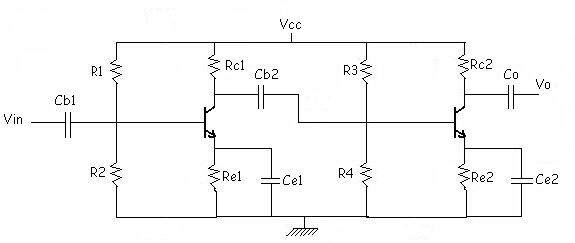Home
BJT
single stage amplifier designing
FET single stage amplifier designing
BJT multistage amplifier designing
Power amplifier designing
Solved problems

[If ratio of output impedences is not given then assume Rc1/Rc2 = 2]
Overall voltage gain, Av = Av1 * Av2
[Substitute Av2 in terms of Av1 or vice versa & find Av1 & Av2]
[If you have to select a transistor, select BC 147B for its higher
inputimpedence & hfe]
[RL' = (Rc2) parallel (RL) or RL' = Rc2 if RL is not given]
[if min voltage gain is specified, use hfe min. If some specific voltagegain is specified, use hfe typ]
[Calculate RL' & Rc2]
If Vo is not given then
Vceq = Vcc/2
Vre2 = 10% to 20 % of Vcc
Vrc2 = Vcc - Vceq2 - Vre2
Icq2 = Vrc2/Rc2
Re2 = Vre2/Icq2
[Select lowerstandard value so that drop across Re is less which increases
gain of the output]
Ic2 peak = Vo peak/ RL2
Assume Vre2 = 2 V
Vcc = Vceq + Icq(Rc2 + Re2)
[Select on higher side]
S = (hfe + 1)/(1 + (hfe * Re2)/(Rb2 + Re2))
Find Rb[Do not standardise]
Vr4 = Vbe + Vre
Vr3 = Vcc - Vr2
Assume Vbe = 0.6V [for Si, 0.3 for Ge if not specified]
R3/R4 = Vr3/Vr4 .............(A)
[Get R3 in terms of R4 & substitute in Rb2]
Rb2 = R3 parallel R4 = (R3 * R4)/(R3 + R4)
Find R4
[Select lower standard value to make circuit indepent of beta]
Substitute in (A) to find R3
Select higher standard value so that circuit draws minimum current
from supply
Then Av1 = Av/Av2
[RL' = (Rc1) parallel (Rb2) parallel (hie)]
[if min voltage gain is specified, use hfe min. If some specific voltagegain is specified, use hfe typ]
[Calculate RL' & Rc1]
Let Vceq1 = Vceq2
Vrc1 = Vrc2
Vre1 = Vre2
Icq1 = Vrc1/Rc1
Re1 = Vre1/Icq1
s = (1 + hfe max)/(1 + ((hfe max * Re )/(Rb + Re))
Find Rb[Do not standardise]
Vr2 = Vbe + Vre
Vr1 = Vcc - Vr2
Assume Vbe = 0.6V [for Si, 0.3 for Ge if not specified]
R1/R2 = Vr1/Vr2 .............(A)
[Get R1 in terms of R2 & substitute in Rb]
Rb = R1 parallel R2 = (R1 * R2)/(R1 + R2)
Find R2
[Select lower standard value to make circuit indepent of beta]
[Substitute in (A) to find R1]
Select higher standard value so that circuit draws minimum current
from supply
[If Rs[Source resistance] is not specified assume Rs = 0]
Xcb1 = ((Rb) parallel (hie))
Cb1 = 1/(2 * pi * FL * Xcb)
Xcb2 = Rc1 + ((Rb) parallel (hie))
Cb2 = 1/(2 * pi * FL * Xcb)
Xcc = Rc + RL [If RL[load resistance] is not specified thenassume amplifier is connected to a similar next stage. Hence RL = (Rb1)parallel (hie)]
Cc = 1/(2 * pi * FL * Xcc)
[Draw the figure with designed values. Do all this in about 36 - 40
minutes (1.8minper mark)]